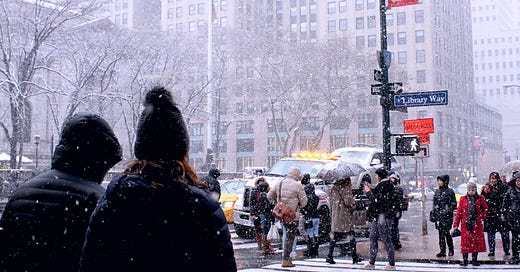Winter in New York: A Masterclass in Making Do
Winter here has a way of turning the mundane into the extraordinary.
Winter in New York City is a paradox—a season that both chills and warms, grates and inspires. The streets are crowded with slush and dreams, the air sharp with the scent of roasted chestnuts and exhaust fumes. From a distance, it can look like chaos: the vast inequities that cleave the city apart are laid bare in the icy wind. On one block, steam billows romantically from a manhole as tourists snap selfies; on the next, someone huddles against a subway grate for warmth. The city’s disparities are written into its winter landscape, as stark as the bare trees in Central Park.
And yet, even in this season of long nights and hard truths, there’s a defiant vitality that pulses through New York. As an anthropologist, I’ve spent years studying human resilience, but no textbook could prepare me for the lessons found on a snow-dusted city corner. People here fight—not just for survival but for something more profound: a life worth living. Winter doesn’t just expose the fractures in our social fabric; it also reveals the threads of connection that hold us together.
Consider the subway car. In the summer, it’s a sweatbox, a test of endurance. In winter, it becomes a kind of hearth. Strangers exchange knowing glances as their scarves drip with melted snow. Someone offers a seat to a parent with a stroller, a tiny gesture that feels monumental when the world outside is unforgiving. The subway is no utopia—it’s still overcrowded, often late, and sometimes tense. But in winter, it becomes an ecosystem of shared warmth, a microcosm of what’s possible when people endure together.
On the sidewalks, bundled-up vendors sell tamales and hot cider, the aromas mingling like a cultural dialogue in steam form. Kids in puffy jackets wobble on ice patches, their laughter cutting through the gray. Even the pigeons seem to double down on their commitment to life, pecking defiantly at frozen crumbs. There’s a humor to it all, a slapstick quality that reminds us that life’s absurdities are best met with a wry grin. Winter here has a way of turning the mundane into the extraordinary: the sight of a dog in a sweater or the sound of a saxophone cutting through the cold can feel like miracles.
Of course, the fight is not always picturesque. The city’s flaws are glaring in winter: underfunded shelters brimming beyond capacity, heating systems failing in public housing, workers braving brutal conditions for a wage that barely covers rent. These realities are as much a part of the season as twinkling lights and holiday markets. And yet, hope persists. Not as a naive optimism, but as a stubborn refusal to give up. It’s there in the volunteers handing out blankets on a freezing night, in the neighbors organizing to ensure no one gets evicted, in the artists finding beauty in a snow-covered fire escape.
Anthropologists often talk about the concept of "making do"—the ways people creatively adapt to their circumstances. In New York, winter is a masterclass in making do. It’s a season that demands resourcefulness and rewards it with moments of surprising grace. A shared laugh over a sidewalk spill. A stranger handing you a lost glove. The electric joy of the first proper snowstorm, when even the most jaded New Yorkers find themselves marveling at the city cloaked in white.
Winter here is not just a test of endurance; it’s a proving ground for community. It forces us to confront the question: How do we build lives worth living in the face of cold, literal and metaphorical? The answer, it seems, is together. Through grit and generosity, humor and hope, we make a life—not perfect, but undeniably alive. And when the thaw comes, as it always does, we emerge not just intact, but stronger, ready to face the next season with the same irrepressible spirit.




